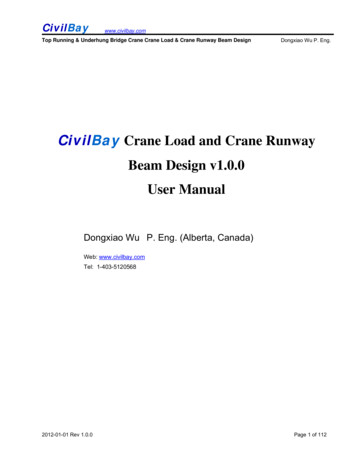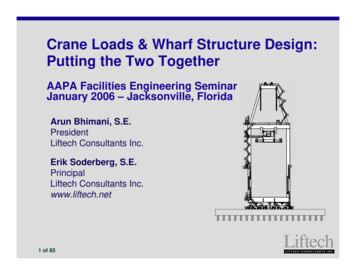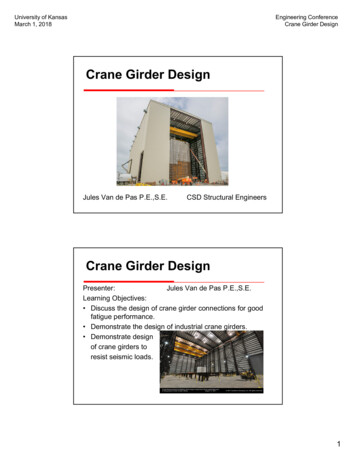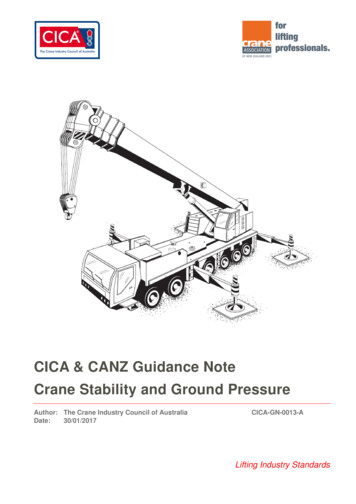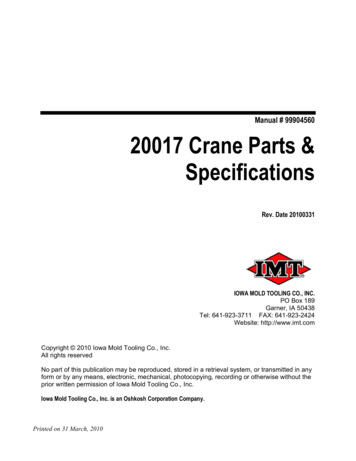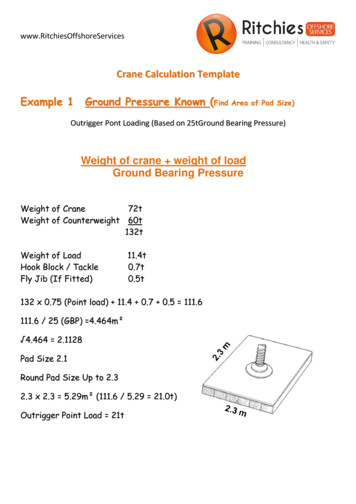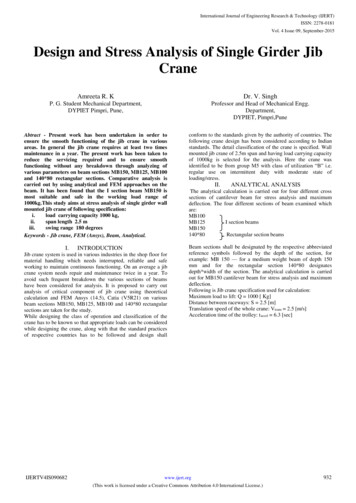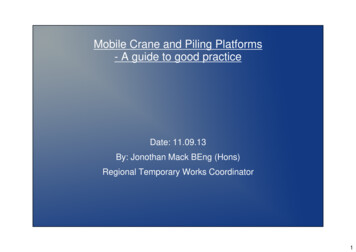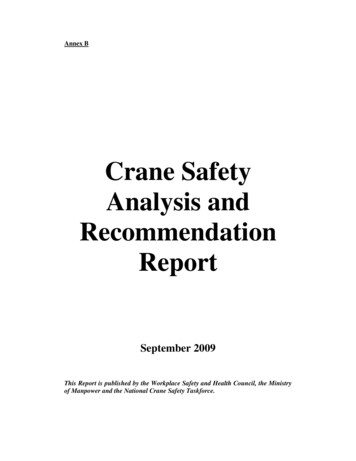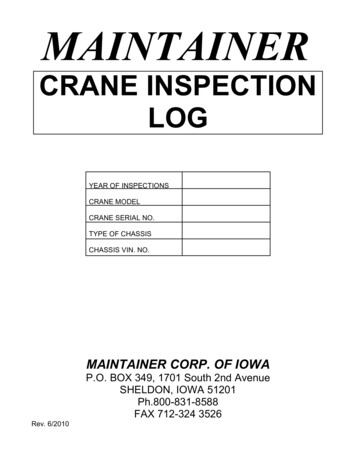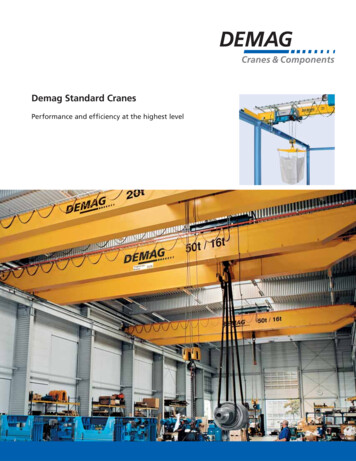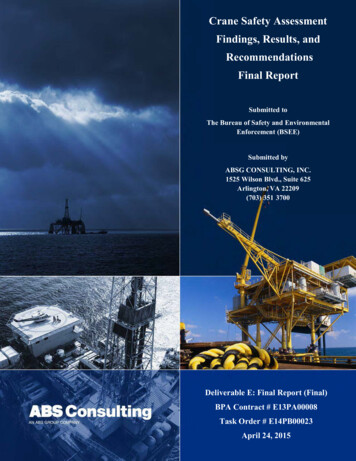
Transcription
MASTER CATALOGCAMSHAFTS VALVE TRAIN IGNITIONwww.cranecams.com
Cams.from Beginning to End!Genuine Crane 8620 and 9310 Steel Billet Cams. TheStrongest Available!Our famous carburized roller cams begin as 8620 or 9310 alloy steel billet bar stock.Each cam then undergoes numerous precision manufacturing operations required toproduce a finished cam. You can identify a genuine Crane cam core by the distinctivecopper plating between the lobes! Crane 8620 and 9310 steel billet cam cores areused by prominent racers, engine builders, and manufacturers.Lobe-To-Lobe,Cam-To-Cam Accuracy!Only Crane Cams delivers that famous Crane lobe-tolobe, cam-to-camaccuracy that engine builders trust! Crane Cams arealways measurably moreaccurate because we begin with the industry’s most accurate tooling and end with the industry’s most accuratemanufacturing. all performed in-house, by Crane!Roller Cam Power With HydraulicCam Convenience!The world’s finest, strongest, most durable carburized andinduction hardened steel billet cams and the proven power making capabilities of Crane Cams’ hydraulic roller lobe profiles produce roller cam power with the easy maintenance of a standard hydraulic cam!The World’s Most Powerful Cam Profiles For AllOut Racing!For more than 55 years Crane Cams have powered winners and broken records! Crane-pioneered dual-pattern cam lobe profiles firstappeared in the 1960’s, and are today’s primary component inshattering drag racing’s 330 mph Top Fuel barrier and the Pro/Stock 200mph barrier! When records fall, Crane Cams make it happen!
How to Use This CatalogAbout the CatalogChoosing The Correct CamAll Crane Cams are organized in typical “Make, number ofcylinders, year, engine” fashion, and according to the type oflifter used. Hydraulic, Hydraulic Roller, Mechanical(Sometimes called “solid” or “flat tappet”), and MechanicalRoller. Cam profiles (“grinds”) are listed beginning with themildest duration through the most radical in each liftertype.Each left page begins with the Application column. ThisEach product section is organized in alphabetical order, and column gives basic application information. In the next colin “Make, number of cylinders, year, engine” fashion. Cam & umn is the Cam Series and Grind Number. Next is theValve Train Applications are organized in alphabetical order, RPM Power Range, and then the cam Part Number. “Camby engine make. Cam profiles (“grinds”) are listedOnly” cams usually have a suffix (last) digit “1” in the partbeginning with the “mildest” duration (lowest numericalnumber. Cam & Lifter Kits usually have a “2” digit suffix.duration shown at .050” cam lobe lift) through the “wildest” Application provides additional information about the camduration figures.shaft. If the idle quality is other than stock, it is also noted inthis column. Cam specs data such as valve lift, durationA camshaft Quick Reference Guide precedes the Cam &and lobe separation is shown at the far-right of each camValve Train Applications section. This is a listing with basiclisting. To choose a street performance cam refer tospecifications of all the camshaft grinds that appear in this“Choosing The Right Cam”, and “Getting Information”,catalog. This provides a condensed version of the complete found on pages 13 and 14-15. Note the part number of thecamshaft specification listings that appear on each page of cam you select.the Engine Application section that follows.For the latest all-out race cam profiles or custom grind serCatalog Sections - Pagesvices contact us at: 866-388-5120, FAX: 386-236-9983. Ourhours are normal business hours Monday - Friday, EasternCamshaft Quick Reference Guide - Pages 18-39Daylight Time.This catalog is organized into three separate sections. Firstis the Cam & Valve Train Application pages which includes allthe necessary information needed to choose the rightcamshaft for your needs. Next is the Cam & Valve Train Buyer’sGuide. The Buyer’s Guide contains additional product applications and additional information not found on the regularapplications pages. The final section is the Ignition andIgnition Buyer’s Guide pages.Cam & Valve Train Applications - Pages 40-283Valve Train Buyer’s Guide - Pages 284-371Ignition - Pages 386-419Choose the correct valve train componentsYou can find these by reading right, across the page. Fordetailed info and applications on Valve Train Componentssee the Buyers Guide section, pages 284-371.Choosing The Correct IgnitionBeginning on page 386 is the Ignition section where you willfind all of the technical information needed to choose thecorrect Ignition components for your application.Product Emissions CodesProduct Emissions Codes For California Air Resources Board (CARB) RegulationsThe product Emissions Code is designed to aid in determining the correct application of emissions related motorvehicle components. Please use our Master Catalog to be sure that purchases comply with all emission laws.Product bearing this product identification code has been granted a California Air Resources Board (CARB)exemption (“EO” number), or is a direct or consolidated replacement part. It is 50-state legal, per the manufacturer’sGreen application guide.1The manufacturer of the product bearing this identification code represents that it has not been found, nor is itbelieved to be, unlawful for use under provisions of the Clean Air Act, per the manufacturer’s application guidelines.Blue This product is not legal for sale or use in the State of California (or in states which have adopted California emissionstandards) except on pre-emission-controlled vehicles/motor vehicle engines (pre-1966 model years).2Products bearing this product identification code are legal only for off-highway use (except CA or states that havestandards), or pre-emissions controlled engines (pre-1966 domestic vehicles certified to CA standards, pre-1968Amber domestic vehicles certified to federal standards and all pre-1968 foreign vehicles), per the manufacturer’s applicationguide.3866-388-5120 386-236-9983 FAX3
Table of ContentsHow to Use This Catalog3Crane Cams History6-7Cam and Valve Train Applications8-283Crane Camshaft Series10-11How the Cam and Valve Train Section is Organized12Basic Tips on Choosing the Right Cam13Getting Information14-15Advance Tips to Choose the Proper Camshaft16-17Camshaft Quick Reference Guide18-39Camshaft and Valve Train Applications40-283Chevrolet Small Block V8 Tech Tips & Notes54-55Chevrolet Big Block V8 Tech Tips & Notes108-109Chrysler Small Block V8 Tech Tips & Notes152-153Chrysler Big Block V8 Tech Tips & Notes168-169Ford Small Block V8 Tech Tips & Notes194-195Ford Big Block V8 Tech Tips & Notes242-243Oldsmobile and Pontiac V8 Tech Tips & Notes270-271Valve Train Buyers Guide284-385Camshaft Components286-287Distributor-Magneto Drive Gears288-290Fuel System 04-309Rocker Arms & Accessories312-3274CRANECAMS.COM
Table of ContentsTiming Chains and Components328-329Tools330-332Vacuum Kits and Accessories333Valve Springs334-347Valve Spring Retainers348-359Valve Stem Locks360-361Promotional Items364How to Identify Your Crane Cam365Custom Ground Cams366Camshaft Recommendation Form367Regrind and Special Cam Service368-369Other Engine Applications370-371Flat Tappet Camshaft Break-In Procedure372-373Adjusting the Valve Train374-376Commonly Asked Valve Spring Questions377-378Commonly asked Valve Train Questions379-380Degreeing the Cam381-383Cam Timing Explained384Understanding the Cam Specification Card385Ignition Section386-419Part Number / Page Index420-433Warranty434866-388-5120 386-236-9983 FAX5
Crane Cams HistoryCrane Cams HistoryCrane Cams was originally knownas known as “Crane EngineeringCompany, Inc.”, and was founded in1953. In 1970 the original name, “CraneEngineering”, was shortened to “CraneCams, Incorporated”, better defining thecompany’s products and market of thatera.From that very humble beginning,Crane Cams has evolvedinto a manufacturing and marketingcompany. Amazingly, it all began in anunused corner of the company ownedby the founder’s father’s machine shop.The founder, a young apprenticemachinist, became interested in “souping-up” his flathead Ford V-8 hot rod.Like most others, he was strongly influenced by the various “hot rodding”magazines, ordering his first cam from aCalifornia cam company’s ad. Thefounder’s machinist’s training and hotrodder’s ingenuity had already taughthim that camshaft design and accuracyexacts a critical effect on engine power.He also knew he was easily capable ofdesigning and manufacturing camshafts. What’s more, he knew he coulddesign more powerful, far more accurate and repeatable camshafts.Although money was scarce, theyoung apprentice traded his way into awell-used cylindrical grinder. In rebuilding this old, used machine he quicklydeveloped cam manufacturing and6design knowledge. His initial “homemade” cams were accurately made andsurprisingly more powerful than anything he’d previously purchased. Otherlocal hot rodders soon found out, andbegan buying his camshafts. The reputation of the backroom Crane cam company spread quickly across Florida andfurther into the Southeast. In response,Crane Engineering Company wasfounded, which was an impressivename for a tiny yet highly ambitiousfirm.By the mid-1950’s the flathead Fordand early overhead-valve Oldsmobileand Cadillac V-8’s were replaced by thepowerful, compact Chevrolet 265-283V-8 engine family. It seemed that withthe early small-block Chevys came asurge of growth for all forms of autoracing. Drag strips and oval tracks suddenly appeared, not only across Florida,but the nation, and the tiny backroomcam company grew as well.In 1960, a Georgia Tech Universityengineering student and weekend dragracer, Pete Robinson, bought a Cranecam for his supercharged Buick powered 1940 Ford. After success on thestreet and at the drags, Robinson soldthe ‘40 and bought a dragster chassisfrom the Dragmaster Chassis company,in California. Pete carefully assembled astroker crankshaft, supercharged, smallblock Chevy, and installed a Crane rollercam. Robinson’s new car ran well onAtlanta area tracks and at a few NHRADivision 2 events. On a whim, heentered the “Southwind” dragster intothe field at the 1961 NHRA Nationals, anevent that had previously been dominated by California based cars and drivers.A virtual unknown, Robinson’s littlesingle-engine dragster shocked the racefield and the nation, winning TopEliminator and smashing records in amajor upset. Several other Crane-CRANECAMS.COMcammedracers werealso successful, butit was“SneakyPete”Robinsonand CraneCams thatsuddenlycapturedthe racing world’s imagination!Soon, word of the amazing powerproduced by Crane Cams reached circletrack racers. This reputation attracted anumber of racers and engine buildersincluding: A.J. Foyt, Red Farmer, TheWood Brothers, Bud Moore, Bill Elliott,Junior Johnson, Dale Earnhardt, RichardPetty, Darrell Waltrip, Bobby Allison,Donnie Allison, Cale Yarborough, andDavid Pearson, all using Crane Camsand winning heat and feature circletrack races across the South.Crane Cams prospered greatly during the “car culture” years of the 1960’s,and soon outgrew the building wherethe founder’s father had once operatedhis own machine shop. In 1965, CraneEngineering purchased property andbegan construction on a brand newbuilding. The firm moved into its brandnew facilities in January of 1966, allowing an expansion of its product line andservices. Soon Crane introduced itshallmark, gold-anodized, full-roller aluminum rockers, was granted a U.S.Patent on a brand new roller lifter
Crane Cams HistoryCrane Cams History (continued)design, began selling mass-produced,custom-ported, all-out racing cylinderheads, heat treated chromemoly pushrods, aluminum, steel and titaniumvalve spring retainers, machined steelvalve locks, high-rev kits, and stud girdles. Crane’s rapidly expanding productline was chocked full of unique andinnovative items, all engineered toboost horsepower and reliability in raceengines as well as street performanceapplications. That plus the huge successthat Crane cammed racers were enjoying firmly established Crane as theindustry’s No. 1 cam company.It was also during this time CraneCams became a pioneer in the scienceof computerized cam lobe design.Previously, cam profile designs requiredlengthy, tedious mathematical exerciseswith a slide rule or mechanical calculator. Computer technology slashed thistime and substantially increased lobeaccuracy. For Crane Cams, the result wasan explosion of knowledge gathered,expanded and utilized. Computerizationof the science of cam lobe profiledesign also enabled Crane’s design staffto explore new possibilities in cam andvalve train function. Each day broughtnew innovations and a tremendousamount of data that could all beapplied to the design and manufactureof new, even more powerful camshafts!As Detroit accelerated and expanded its motorsports programs, CraneCams was tapped as a provider of camdesign knowledge as well as becominga trusted supplier to the automotiveindustry. Ford, American Motors andChrysler all selected Crane Cams as theirchoice for a variety of racing and streetperformance related products and services.For many years Crane had purchased its steel cam cores fromUniversal Camshaft Company, ofMuskegon, Michigan. When that company became available in 1975, Craneacquired it, thereby providing itself witha stable, long-term source for steel camcores. That operation was moved in1981 to a newly constructed manufacturing center in Daytona Beach. In 1985the entire company left its foundingcity, Hallandale, Florida, and relocatedto Daytona Beach.In February, 1994, Crane Camsacquired Camshaft Machine Companyand its plants in Michigan and Indiana.To better reflect its new market mix, thecompany’s name was changed to CraneTechnologies Group, Inc.Seeking to return to its core camand valve train business and its roots inthe performance market, Crane soldCamshaft Machine to Federal-MogulCorp. in early 1999.In 1989 Crane Cams recognized thepotential for performance camshafts,valve train components, ignitions andelectronics for the rapidly growingHarley-Davidson motorcycle market.Today, Crane Cams, Crane valve trainproducts and Crane FireBall ignitionsare among the industry’s most popularfor cruising, street performance and racing. Crane is also an annual participantin many of the world’s largest motorcycle gatherings.Crane Cams entered the world ofelectronic ignitions by acquiring AllisonElectronics in 1990. The original product line was completely reengineered,updated and expanded and is now marketed as Crane FireBall Ignitions.FireBall ignitions have since become theindustry’s most technologicallyadvanced for racing and street applications. Other products include FireBallengine controls and FireWire, a premium quality, double silicone jacketed,reactive-core line of race-proven sparkplug wires.Also, Crane’s optical trigger/fiberoptics distributor is approved for competition by NASCAR and used by manyleading teams. Likewise, Crane ignitionsare employed by top runners in ARCA,ASA, USAR and other sanctioned series.Crane’s billet distributors, ignitions, coilsand FireWire spark plug wire are available for many drag racing applications.In 2009, Crane Cams was purchased byGeorge and Ken Smith. George is wellknown in NHRA circles for the designand introduction of the S&S-poweredBuells that have become a dominantforce in the Pro Stock Motorcycle classand won the 2009 NHRA Full ThrottlePoints Championship for Hector Arana.Given the resources of the company’snew ownership, Crane Cams now hasan expanded amount of state-of-the artmanufacturing firepower and R&D at itsbeck and call. This includes a substantialnumber of the latest CNC machiningcenters (including automated palletchanging), the ability to produce fullydigitized camshafts using Landis CNCequipment, as well as grinding cams viatraditional methods using productionmasters, dyno cells, Spintrons and afully government-certified emissionslab. Quality control is aided by state-ofthe-art testing equipment such Zeissoptical and Adcole computerized devices, along with a dedicated staff that hashelped to maintain the industry’s highest standards since “day one.”New facilities have been set up inDaytona Beach, with a large number ofveteran Crane Cams employees continuing in their technical and manufacturing capacities. The engineering staffutilizes the latest in design and analytical software to continue the companytradition of developing the best possible components for each application.Customers can be secure in theknowledge that given George Smith’sracing background (which includesstudying camshaft and valve train technology under the tutelage of HarveyCrane) and penchant for perfection, thecompany will strive to lead the industryin quality and performance whileimproving product availability to levelsthat racers require.With the industry’s largest camshaft database, which exceeds 80,000profiles, an impressive manufacturingcapability, and an experienced tech staffready to provide racers with race-winning valve train and ignition components.866-388-5120 386-236-9983 FAX7
Camshaft Table of ContentsCam and Valve Train Applications8-283Crane Camshaft Series10-11How the Cam and Valve Train Section is Organized12Basic Tips on Choosing the Right Cam13Getting Information14-15Advance Tips to Choose the Proper Camshaft16-17Camshaft Quick Reference Guide18-39Camshaft and Valve Train Applications40-283American Motors/Jeep 6 Cylinder 64-05 , 199-258 cu.in.American Motors/Jeep V-8 66-91 , 290-401 cu.in.Buick V-8 67-76 , 400-455 cu.in.Cadillac V-8 68-81 , 368-500 cu.in.Chevrolet 6 Cylinder 62-84 , 194-250 cu.in.Chevrolet 60 V-6 80-94 , 173 cu.in. 3.1-3.4LChevrolet 90 V-6 92-02 , 4.3LChevrolet Small Block V8 Tech Tips & NotesChevrolet V-8 57-87 , 262-400 cu.in.Chevrolet V-8 87-92 , 305-350 cu.in.Chevrolet V-8 87-99 , 305 (5.0L) - 350 (5.7L) cu.in.Chevrolet V-8 92-96 , 5.0-5.7L LT1Chevrolet V-8 97-13, 4.8-6.2L LS1, LS2, LS3/L92, LS6Chevrolet V-8 06-13, 7.0L LS7Chevrolet V-8 07-13, 6.2L LS3/L92/Vortec 6.2 with three bolt timing gearChevrolet Big Block V8 Tech Tips & NotesChevrolet V-8 58-65 , 348-409-427 (Z-11) cu.in.Chevrolet V-8 67-95 , 396-454 cu.in.Chevrolet V-8 96-00 , 454 (7.4L)-502 (8.2L) cu.in. Gen VIChevrolet V-8 01-08 , 8.1L L18Chrysler/Dodge Neon 4 cyl. 95-05 , 2.0L SOHC 4VChrysler/Dodge Neon, PT Cruiser 4 cyl. 95-10, 2.0-2.4L DOHC 4VChrysler Small Block V8 Tech Tips & NotesChrysler Hemi V-8 51-56 301-331-354 cu.in. and 57-58 392 cu.in.Chrysler-Dodge-Plymouth “LA” V-8 64-87 , 273-360 cu.in.Chrysler-Dodge-Plymouth “LA” V-8 86-91 , 318 (5.2L)-360 (5.9L) cu.in.Chrysler-Dodge-Plymouth Magnum V-8 92-02 , 5.2-5.9LChrysler-Dodge V-8 03-10 , 5.7-6.1L HemiChrysler Big Block V8 Tech Tips & 2-153153A-153B154-163164-165164-165166-167168-169
Camshaft Table of ContentsChrysler-Dodge-Plymouth “B” V-8 58-78 , 350-440 cu.in. Single Bolt — see pages 170-179Chrysler-Dodge-Plymouth “B” V-8 70-78 , 383-440 cu.in. Three BoltChrysler-Dodge-Plymouth V-8 “Hemi 426” 66-71Ford 4 Cylinder 74-87 , 2.3L SOHC & 83-87 2.0L SOHCFord 4 Cylinder 88-98 , 2.3L SOHCFord Zetec 4 Cylinder 95-02 , 2.0L DOHC 4V ZetecFord Duratec 4 Cylinder 02-05 , 1.8-2.3L DOHC 4V DuratecFord 6 Cylinder 65-96 , 240-300 cu.in.Ford Small Block V8 Tech Tips & NotesFord-Mercury V-8 62-87 , 221-302 cu.in.Ford-Mercury V-8 85-95 , 302 (5.0L) cu.in. H.O.Ford-Mercury V-8 69-93 , 351W & 82-84 302 (5.0L) cu.in. H.O.Ford-Mercury “Cleveland” V-8 70-82 , Boss 351-351C-351M-400 cu.in.Ford-Mercury V-8 91-10 , 4.6-5.4L SOHC 2VFord-Mercury V-8 93-10 , 4.6-5.4L DOHC 4VFord-Mercury V-8 05-10 , 4.6-5.4L SOHC 3VFord Big Block V8 Tech Tips & NotesFord-Mercury V-8 63-76 , 352-428 cu.in. “FE”Ford-Mercury V-8 68-97 , 370-460 (7.5L) cu.in.Honda VTEC 4 cyl. 92-00 Civic EX , SOHC 4VMG TC-TD-TF 4 cyl. 40-54 , 1250ccMGA-MGB 4 cyl. 57-80 , 1598-1798ccMG Midget-Mini-Sprite 4 cyl. 57-84, BMCA 848-1275ccMitsubishi 4G63/4G63-T 4 cyl. Eclipse-Talon-Gallant 1989-1999 , 2.0L DOHC 4VMitsubishi 420A 4 cyl. Eclipse non-Turbo 1995-1999 , 2.OL DOHC 4VMitsubishi 4G63BT EVO 8 4 cyl. 2003-2005 , 2.OL DOHC 4VOldsmobile and Pontiac V8 Tech Tips & NotesOldsmobile V-8 67-84 , 260-455 cu.in. 39 Bank AnglePontiac V-8 55-81 , 265-455 cu.in.Toyota 20R-22R-22RE 4 cyl. 74-89 , SOHC 2V866-388-5120 386-236-9983 82-2839
Crane Camshaft SeriesCrane Camshaft SeriesBlueprintTM Cams For MusclecarsCrane BlueprintTM musclecar cams are duplicates of popular original equipment musclecarcams from the 60’s and 70’s. These hydraulicand mechanical cams are computer smoothedfor added performance and increased valvetrain life. They are an excellent choice for atrue musclecar restoration where engineauthenticity, correct idle quality and detail arecritical to the restoration. This catalog lists ourmost popular Blueprint grinds, but many moreare available on request. We have an extensivelibrary of profiles, enabling us to match thecorrect year and horsepower, or factory partnumber, camshaft for your specific requirements.We also provide regrinding services for therestoration of older and antique camshafts,when outright cam cores are no longer available. Contact a Crane Technical Service representative at: 866-388-5120, FAX 386-236-9983.EnergizerTM HydraulicEnergizer street performance cams are produce sizeable torque, HP, and RPM increases atan affordable price. Energizer cams use thesame computer techniques and software thatdeveloped the world’s fastest and quickestcams. These single-pattern cams have tighterlobe separations, for added torque, mid-rangepower, throttle response and that popularlumpy idle for non-computer controlled V-8engines. They are available as camshaft andlifter kits, or as a camshaft only.10Emissions Legal-Computer CompatibleCrane emissions legal comshafts produceamazing increases in torque, horsepower, andthrottle response while extending the rpmpowerband of computer controlled performance passenger cars, 2x4 and 4x4 lighttrucks. Emissions legal comshafts also permitfull function of stock engine control computers. Emissions legal comshafts also work wellwith performance “chips.” Emissions legal camshaft profiles are available in both standard“flat-faced” hydraulic lifter cast-billet designsas well as Hydraulic Roller designs. CraneEmissions legal comshafts are available forGM, Ford, and Dodge Magnum V-8 enginesas well as selected GM V-6 engines.Hydraulic, Hydraulic Roller,Mechanical Non-Roller andMechanical Roller CamsMost cams feature a dual-pattern lobe design,for optimum intake/exhaust flow, maximumlow-end, mid-range and upper rpm power.Hydraulic cams begin at 248 advertised duration (192 /204 @ .050”), .400/.427” valve lift, upthrough 312 /319 advertised duration(262 /270 @ .050”) and .636” valve lift. Manyare designed to maximize the effects of powerenhancing systems such as nitrous-oxide,superchargers, and turbochargers.Whenever practical, the lobes are optimized totake full advantage of the maximum flat-facedlifter diameter of each engine family (such as.842” for most GM, .875” for Ford, and .904” forAMC/Jeep and Chrysler). This produces thebest powerband without sacrificing durability,idle quality, and responsiveness. These includeCrane Cams’ Hydraulic Roller and Street-Rollermechanical roller cams.CRANECAMS.COM
Crane Camshaft SeriesCrane Camshaft Series (continued)Hydraulic Roller CamsCrane Hydraulic Roller cams offer the sizeablepower and torque increases that are availableonly with roller cams, plus the low-maintenance convenience of a hydrauliccam. Hydraulic Roller cams are available forretrofit (converting earlier non-hydraulic rollercam engines), and to increase power output ofengines already equipped with hydraulic rollercams. Crane Hydraulic Roller cams are produced using our own industry standard, steelbillet cam cores, carburized or induction-hardened for strength and wear resistance.Hydraulic Roller cams are available as catalogued plus custom grind lobe availability.Street-Roller Mechanical Roller CamsStreet-Roller cams are available in a variety ofprofiles, ground on our famous steel billet camcores and fitted with iron distributor drivegears (where applicable). Street-Roller camlobe profiles feature exclusive lobe rampdesigns that minimize valve train noise andincrease valve train durability for street drivingengine applications. Street-Roller profiles arealso available for nitrous-oxide systems, superchargers, and turbochargers, offering evengreater horsepower and torque output forthese power enhancing systems.Saturday Night SpecialTM Cams ForCircle Track And Drag RacingCrane Saturday Night Specials are hydraulicand mechanical lifter cam, lifter, and valvespring kits, primarily developed for rules-limited oval track racing and ET-Bracket drag racing applications. For oval track racing theyproduce maximum off-the-corner torque, withstrong upper-rpm horsepower to pull thestraightaways. For drag racing they producemaximum torque, for starting line launch andthe upper rpm power to pull through thegears. Saturday Night Special cams are available for Small-block and Big-block Chevy;289-302-351W Ford; and 429-460 Ford V-8’s.(For circle track racing we also offer manyother profiles for specific track cam rules notcovered by Saturday Night Specials. ContactCrane Technical Services for details. 866-3885120).Crane Racing Cams For All-OutCompetitionCrane pioneered the use of computers forlobe profile design and dual-pattern cam profiles. With over 80,000 grind numbers in ourcam library, we’ve designed and producedcams for drag racing, circle track, road racing,boat racing, 4x4 off-road, mud racing, truckand tractor pulling, even airboats and swampbuggies. Some of our most popular racingprofiles are listed in this catalog. We also custom design and grind cams for specific raceengine needs. For more information contact aCrane Technical Service rep at: 866-388-5120,FAX: 386-236-9983.866-388-5120 386-236-9983 FAX11
Crane Cams & Valve Train Products SectionHow the Cam and Valve Train Section is Organized Crane Cam & Valve Train Applications catalog pages are organized by “Make, Numberof Cylinders, Year, Engine” fashion . After locating your desired “Engine” comesthe type of lifter the camshaft is designedfor. These begin with Standard flat-faceHydraulic Lifters, then Hydraulic Rollers,then Mechanical flat-face Lifters (also calledSolids or Flat Tappets), and MechanicalRoller Lifters. Important information on each left-handpage is arranged in columns. ApplicationThis column describes the basic usage thateach cam is intended for, along with anypertinent advised component items to produce the best results. Camshaft Series and Grind NumberIdentifies the cam series and the cam grindnumber. (Grind Number is different fromthe cam Part Number. To order, always usethe cam Part Number.) RPM Power RangeStates the RPM range at which the cam produces maximum torque and horsepower(The engine will typically rev 500-1,000 RPMabove the stated RPM Power Range but notat peak power levels) LiftersThese are the lifters recommended for bestdurability and performance for each camshaft. Upgrade options are also conveniently listed. Complete Cam SpecificationsUnder this bar you’ll find all of the cam’scritical specifications. These include:Degrees Duration @ .050”; AdvertisedDegrees Duration; Degrees LobeSeparation; Open/Close @ .050 Cam Lift;Lash Hot; and Gross Lift. Cam Facts and NotesMore helpful information on the correctapplication of this cam as related to thespecific engine. Also provides helpful hintsto insure proper camshaft and componentapplication and installation. Right Page: Matched Valve Train ProductsProvides part numbers for related valvetrain components and refers to the catalogpage of the Buyer’s Guide catalog sectionwhere more detailed information on therecommended valve train components andthe wide range of optional Valve TrainComponents we offer are located. Camshaft Part Number/Emissions CodeIdentifies the actual Part Number for thiscamshaft. Cams sold as Cam Only (withoutlifters) usually end with the numeral 1. Cam& Lifter Kits include matching Crane lifters.Their Part Numbers usually end in thenumeral 2. The “Emissions Code” states theCalifornia (CARB) emissions designation forthat particular cam.12CRANECAMS.COM
Crane Cams & Valve Train Products SectionBasic Tips on Choosing the Right CamCam selection accuracy begins with knowinghow you intend to use the vehicle, engine anddrivetrain modifications already made orplanned, and the lifter type (Hydraulic, Hyd.Roller, Mechanical (“Solid” or “Flat Tappet”), orMech. Roller you wish to use. You’ll find additional information to help you choose the correct cam on Pages 14 through 17. We urgeyou to take a little extra time now in makingyour selection. This will insure that you makethe right choice, the first time! To choose thecorrect cam and valve train for your engine,vehicle and application follow the steps below:What To Look For First:First, find your engine make, number of cylinders, year, and original engine displacement as listed in cubic inches or metric reference. (Example: Chevrolet, 1986, 350 cu. in.)Decide Which Lifter Style:Decide on the lifter type you wish to use inyour engine. For convenience and ease ofmaintenance we recommend a hydraulic camand lifters, either “flat-face” or hydraulic rollerfor most street performance and daily-drivingapplications.NOTE: Passenger car engines up through1987 model year generally used conv
Chevrolet Big Block V8 Tech Tips & Notes 108-109 Chrysler Small Block V8 Tech Tips & Notes 152-153 Chrysler Big Block V8 Tech Tips & Notes 168-169 Ford Small Block V8 Tech Tips & Notes 194-195 Ford Big Block V8 Tech Tips & Notes 242-243 Oldsmobile and Pontiac V8 Tech Tips & Notes 270-271 Valve Train Buyers Guide 284-385 Camshaft Components 286-287
